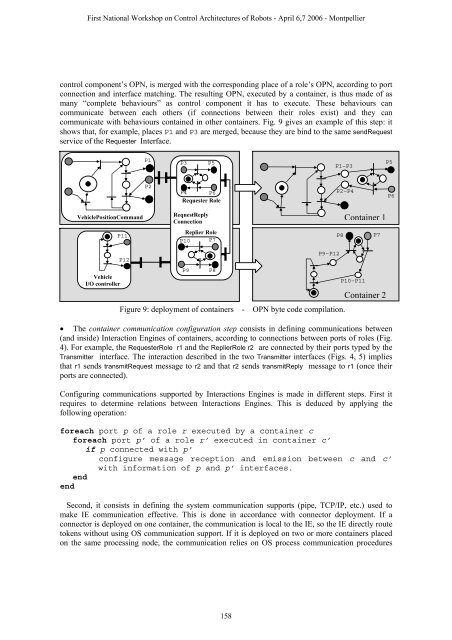Pleading for open modular architectures - Lirmm
Pleading for open modular architectures - Lirmm
Pleading for open modular architectures - Lirmm
You also want an ePaper? Increase the reach of your titles
YUMPU automatically turns print PDFs into web optimized ePapers that Google loves.
First National Workshop on Control Architectures of Robots - April 6,7 2006 - Montpellier<br />
control component’s OPN, is merged with the corresponding place of a role’s OPN, according to port<br />
connection and interface matching. The resulting OPN, executed by a container, is thus made of as<br />
many “complete behaviours” as control component it has to execute. These behaviours can<br />
communicate between each others (if connections between their roles exist) and they can<br />
communicate with behaviours contained in other containers. Fig. 9 gives an example of this step: it<br />
shows that, <strong>for</strong> example, places P1 and P3 are merged, because they are bind to the same sendRequest<br />
service of the Requester Interface.<br />
VehiclePositionCommand<br />
Vehicle<br />
I/O controller<br />
P11<br />
P12<br />
P1<br />
P2<br />
P3<br />
P4 P6<br />
Requester Role<br />
RequestReply<br />
Connection<br />
P5<br />
Replier Role<br />
P10 P7<br />
P9<br />
P8<br />
Figure 9: deployment of containers - OPN byte code compilation.<br />
P1–P3<br />
P2–P4<br />
• The container communication configuration step consists in defining communications between<br />
(and inside) Interaction Engines of containers, according to connections between ports of roles (Fig.<br />
4). For example, the RequesterRole r1 and the ReplierRole r2 are connected by their ports typed by the<br />
Transmitter interface. The interaction described in the two Transmitter interfaces (Figs. 4, 5) implies<br />
that r1 sends transmitRequest message to r2 and that r2 sends transmitReply message to r1 (once their<br />
ports are connected).<br />
Configuring communications supported by Interactions Engines is made in different steps. First it<br />
requires to determine relations between Interactions Engines. This is deduced by applying the<br />
following operation:<br />
<strong>for</strong>each port p of a role r executed by a container c<br />
<strong>for</strong>each port p’ of a role r’ executed in container c’<br />
if p connected with p’<br />
configure message reception and emission between c and c’<br />
with in<strong>for</strong>mation of p and p’ interfaces.<br />
end<br />
end<br />
Second, it consists in defining the system communication supports (pipe, TCP/IP, etc.) used to<br />
make IE communication effective. This is done in accordance with connector deployment. If a<br />
connector is deployed on one container, the communication is local to the IE, so the IE directly route<br />
tokens without using OS communication support. If it is deployed on two or more containers placed<br />
on the same processing node, the communication relies on OS process communication procedures<br />
158<br />
P9–P12<br />
P8<br />
Container 1<br />
P10–P11<br />
P7<br />
Container 2<br />
P5<br />
P6

















